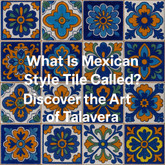What Is Mexican Style Tile Called? Discover the Art of Talavera
If you’ve ever admired colorful, intricately painted tiles in a rustic kitchen or seen a mosaic adorning a courtyard wall, you’ve likely encountered Mexican style tile. But what is Mexican style tile actually called? The answer is Talavera tile. With vibrant patterns, deep historical roots, and artistic appeal, Talavera tiles represent one of the most cherished forms of Mexican craftsmanship still thriving today.
What Is Talavera Tile?
Talavera tile is a type of hand-painted ceramic tile that originated in Puebla, Mexico. It was inspired by Spanish techniques brought over in the 16th century and blended with Indigenous craftsmanship. The result is a bold, colorful tile style known for its distinctive patterns and glossy finish.
These tiles are typically made from a mix of volcanic clay and are hand-glazed in hues like cobalt blue, terracotta red, mustard yellow, and emerald green. Artisans shape and fire each tile before meticulously painting traditional motifs using natural pigments and mineral oxides.
Historical Roots of Talavera Tile
The name “Talavera” traces back to Talavera de la Reina in Spain, where the original majolica pottery style originated. When Spanish settlers came to the Americas, they brought ceramic techniques with them. Mexican artisans in Puebla adopted these methods and combined them with local traditions, giving rise to Talavera as a distinctive art form.
By the 17th century, Puebla had become a major hub of tile production, and its tiles were used to decorate churches, convents, courtyards, and homes. Today, Talavera tiles continue to reflect the blend of Old World influence and Mexican ingenuity.
Where to Find Authentic Talavera Tiles
One of the best places to purchase genuine Mexican tiles is the Mexican Tile Store. They offer a curated selection of handmade tiles sourced directly from skilled artisans in Mexico. Their catalog includes various tile styles such as:
- ✔️ Mexican Color Painted Tiles – bold colors and brushwork
- ✔️ Mexican Pattern Tiles – traditional geometric and floral patterns
- ✔️ Mexican Relief Tiles – sculptural, textured designs
- ✔️ Mexican Painted Tile Murals – large artistic scenes created with tile
- ✔️ Talavera Tile Mixed Designs – a variety of colors and patterns for eclectic layouts
Talavera Tile Design Ideas
Mexican tile isn't just for traditional spaces—designers now incorporate Talavera into everything from modern kitchens to bohemian patios. Some popular applications include:
- ✔️ Kitchen backsplashes with colorful geometric patterns
- ✔️ Stair risers lined with alternating floral tiles
- ✔️ Bathroom walls or vanities featuring bold accents
- ✔️ Garden fountains or fire pits with painted tile borders
- ✔️ Dining tabletops and serving counters tiled for rustic flair
Mixing patterns and colors gives your space personality. For example, you can combine blue-and-white Talavera tiles with plain terracotta for a Mediterranean feel or use relief tiles to add depth to a monochrome kitchen island.
Benefits of Choosing Talavera Tile
Why do so many homeowners and designers choose Talavera tile? Here are some of its key advantages:
- ✔️ 100% handmade and unique—no two tiles are the same
- ✔️ Adds cultural richness and history to any space
- ✔️ Long-lasting and easy to clean
- ✔️ Can be used indoors or outdoors
- ✔️ Environmentally responsible—made from natural clay
Talavera tiles are a sustainable design choice that supports artisan communities in Mexico. Each tile reflects hundreds of years of tradition and carries an artistic story into your home.
How to Maintain Mexican Style Tiles
Maintaining Talavera tile is simple. Wipe with a damp cloth and mild soap—no harsh chemicals needed. Avoid abrasive cleaners to preserve the painted glaze. For outdoor installations, seal the tiles every 1–2 years to prevent fading and moisture damage.
Because Talavera is a handmade product, minor imperfections are part of its charm and authenticity. These include slight color variations or glaze bubbles, which enhance its artisanal character.
Common Motifs and Symbolism in Talavera Designs
Talavera tiles often feature symbolic motifs with cultural significance. Popular designs include:
- ✔️ Florals – symbolizing life and nature
- ✔️ Stars and suns – representing energy and faith
- ✔️ Crosses – often used in religious architecture
- ✔️ Birds and animals – reflecting local fauna and myth
- ✔️ Moorish arabesques – a nod to Spanish heritage
By choosing tiles with meaningful designs, you connect your home to a broader artistic and historical narrative.
How to Decorate With Talavera Tiles
Decorating with Talavera tile allows you to add visual interest without overwhelming the space. For example:
- ✔️ Use tile borders around windows, mirrors, or niches
- ✔️ Create a focal wall in a powder room or patio
- ✔️ Install Talavera tiles around a fireplace mantel
- ✔️ Use colorful accents alongside neutral flooring or walls
Whether your style is rustic, Mediterranean, eclectic, or Southwestern, there’s a way to incorporate Talavera that feels natural and refined.
Final Thoughts
Talavera tiles are more than just decorative surfaces—they are cultural artifacts, functional design pieces, and handcrafted treasures. Rooted in colonial history and made by modern-day artisans, they add color, warmth, and depth to any environment.
So the next time you ask, “What is Mexican style tile called?”—you’ll know the answer is Talavera. But it’s not just a name. It’s a story, a legacy, and a connection to the soul of Mexico.
Ready to explore your options? Discover a wide range of authentic tiles at the Mexican Tile Store and transform your space with the art of Talavera.



